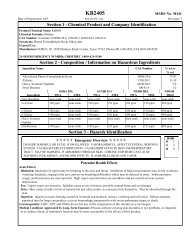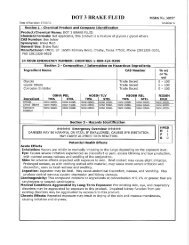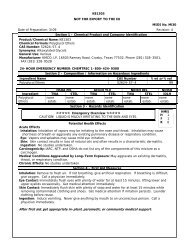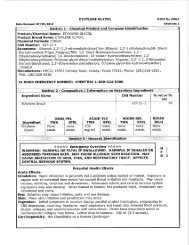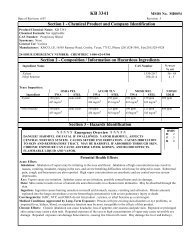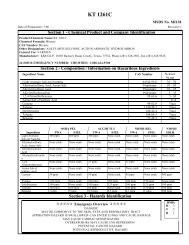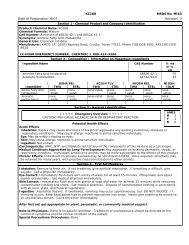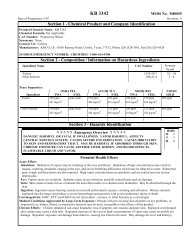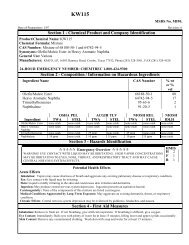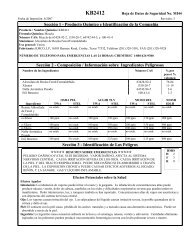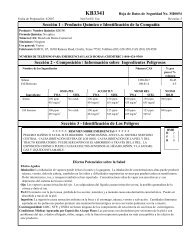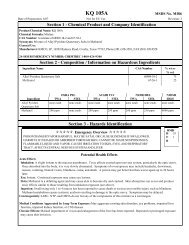KB2603 - KMCO
KB2603 - KMCO
KB2603 - KMCO
Create successful ePaper yourself
Turn your PDF publications into a flip-book with our unique Google optimized e-Paper software.
Revision: 6 <strong>KB2603</strong> Issue Date: 6/07<br />
Chronic Effects: Chronic inhalation can cause headache, loss of appetite, nervousness and pale skin. Repeated or prolonged<br />
skin contact may cause a skin rash. Repeated exposure of the eyes to high concentrations of vapor may cause reversible eye<br />
damage. Repeated exposure can damage bone marrow, causing low blood cell count. May damage the liver and kidneys.<br />
Section 4 - First Aid Measures<br />
Inhalation: Remove to fresh air. If not breathing, give artificial respiration. If breathing is difficult, give oxygen. Call a physician<br />
immediately.<br />
Eye Contact: Immediately flush eyes with plenty of water for at least 15 minutes, lifting lower and upper eyelids occasionally. Get<br />
medical attention immediately.<br />
Skin Contact: Immediately flush skin with plenty of soap and water for at least 15 minutes while removing contaminated clothing<br />
and shoes. Get medical attention. Dispose of contaminated clothing in accordance with all local, state, and Federal regulations.<br />
Ingestion: Aspiration hazard. If swallowed, vomiting may occur spontaneously, but DO NOT INDUCE. If vomiting occurs, keep<br />
head below hips to prevent aspirations into lungs. Never give anything by mouth to an unconscious person. Call a physician<br />
immediately.<br />
After first aid, get appropriate in-plant, paramedic, or community medical support.<br />
Note to Physicians: There is no specific antidote. Treatment of overexposure should be directed at the control of symptoms and<br />
the clinical condition of the patient.<br />
Special Precautions/Procedures: None.<br />
Section 5 - Fire-Fighting Measures<br />
Flash Point: 104°F<br />
Flash Point Method: CC<br />
Burning Rate: Not Determined<br />
3<br />
Autoignition Temperature: 867 °F (464 °C) data for xylene<br />
2 0<br />
LEL: 1.0 % v/v (data for xylene)<br />
—<br />
UEL: 7.0% v/v (data for xylene)<br />
Flammability Classification: Flammable liquid and vapor<br />
Extinguishing Media: Dry chemical, foam or carbon dioxide. Water spray may be used to keep fire exposed containers cool, dilute<br />
spills to nonflammable mixtures, protect personnel attempting to stop leak, and disperse vapors.<br />
Unusual Fire or Explosion Hazards: Above flash point, vapor-air mixtures are explosive within flammable limits noted above.<br />
Contact with strong oxidizers may cause fire. Sealed containers may rupture when heated. Sensitive to static discharge.<br />
Hazardous Combustion Products: Carbon monoxide, carbon dioxide, and unidentified organic compounds.<br />
Fire-Fighting Instructions: Do not use direct water stream to extinguish fires. Product may travel with water and reignite. Vapors<br />
can flow along surfaces to distant ignition source and flash back. Do not release runoff from fire control methods to sewers or<br />
waterways.<br />
Fire-Fighting Equipment: Because fire may produce toxic thermal decomposition products, wear a self-contained breathing<br />
apparatus (SCBA) with a full facepiece operated in pressure-demand or positive-pressure mode. Wear full protective clothing.<br />
Section 6 - Accidental Release Measures<br />
NFPA<br />
Spill /Leak Procedures: Ventilate area of leak or spill. Remove all sources of ignition. Wear appropriate personal protective<br />
equipment. Isolate hazard area. Keep unnecessary and unprotected personnel from entering. Use non-sparking tools and<br />
equipment. Do not flush to sewer.<br />
Small Spills: Contain and recover liquid when possible. Collect liquid in an appropriate container or absorb with an inert material<br />
(e.g. vermiculite, dry sand), and place in a chemical waste container. Do not use combustible materials, such as sawdust.<br />
Large Spills<br />
Containment: Wear respirator and protective clothing as appropriate. Shut off source of leak if safe to do so. For large spills,<br />
dike far ahead of liquid spill for later disposal. Do not release into sewers or waterways.<br />
Cleanup: Contain and recover liquid when possible. Collect liquid in appropriate container. Absorb residue with an inert<br />
material. Consult with your environmental department for detailed clean up instructions.<br />
Regulatory Requirements: Follow applicable OSHA regulations (29 CFR 1910.120). CERCLA requires reporting spills and<br />
releases to soil, water and air in excess of reportable quantities. The toll free number for the US Coast Guard National Response<br />
Center is (800) 424-8802.<br />
Page 2 of 5



